AMD's Radeon HD 5670: Sub-$100 DirectX 11 Starts Today
by Ryan Smith on January 14, 2010 12:00 AM EST- Posted in
- GPUs
Power, Temperature, & Noise
As a note here, since NVIDIA does not offer a reference GT 240, we’re using our Asus 512MB GDDR5 GT 240 as our reference 240. It does have a dual-slot cooler, so the cooler is not directly comparable to the blower on the 5670.
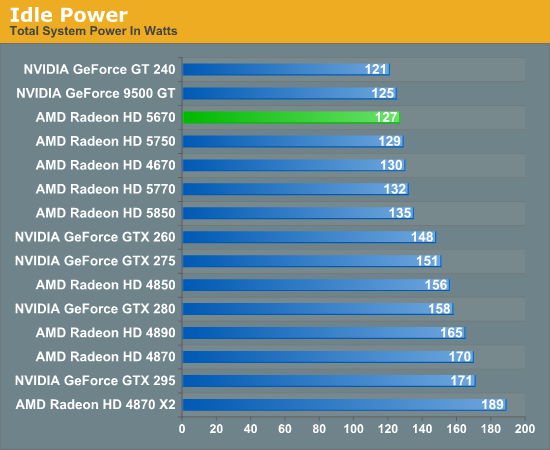
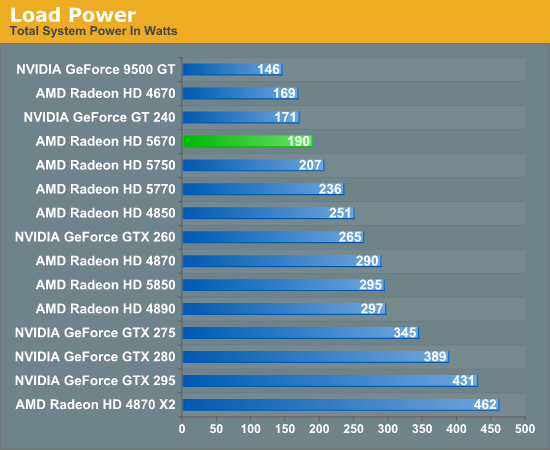
The one thing AMD can’t quite best the GT 240 at is idle power. Here the GT 240’s sub-10W idle means the 5670 idles slightly higher. With that said it’s the 3rd lowest card of all time, behind only the GT 240, and the significantly slower 9500 GT.
Load power paints a different picture however, and this is where the concept of a “power virus” pokes its head up again. The 5670 has a lower TDP than the GT 240 according to the specs published by AMD and NVIDIA - at 61W and 70W respectively - and we have no reason to doubt these numbers. But here the load power of the 5670 is much higher, by just shy of 20W. You’ll notice here that the 4670 is also much lower in spite of similar specs – all of this leads us to believe that the other cards are throttling themselves some as compared to the 5670, whose VRM protection features let it run away compared to these cards. Compared to the 5750 the data is correct, so that makes a better reference point than the GT 240 or 4670.
Accounting for these quirks, the 5670 should be between the 3rd and 2nd lowest power consuming card that we have on-hand.
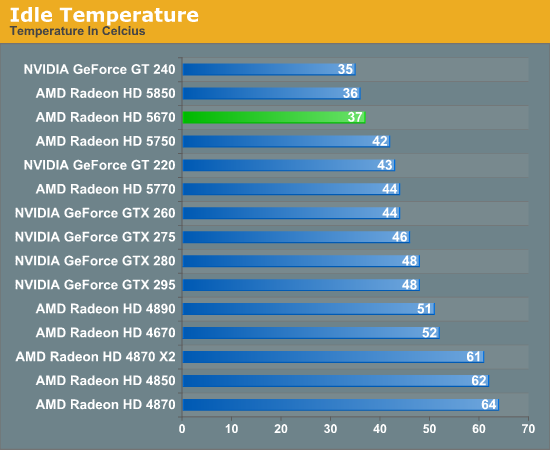
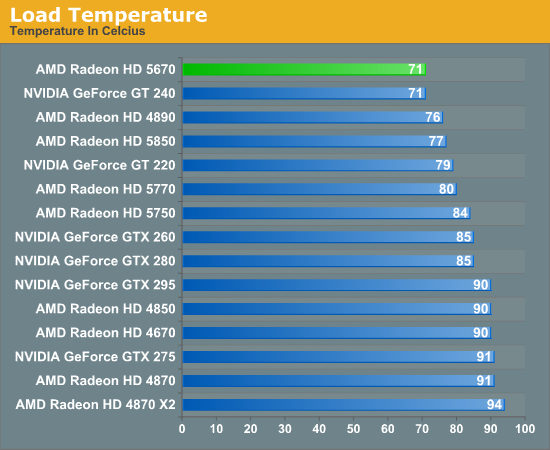
Less power usage leads to less heat, and in this case this means the 5670 once again trails the GT 240, which benefits from said lower power usage and the dual-slot cooler on our specific card. It’s still the 3rd best card however, beating everything except said GT 240 and the remarkably cool 5850.
At load, the picture looks very good for AMD. Even though we’re using a dual-slot cooler, thanks to the low load power usage we’re looking at a tie for the lowest load temperatures we’ve ever recorded. The dual-slot GT 240 ties at 71C, and we’re several degrees from anything else. The results are particularly good compared to the 4670, which was an inferno at 20C higher in this test.
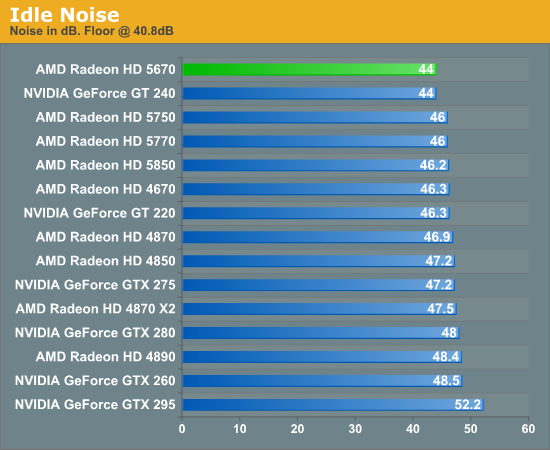
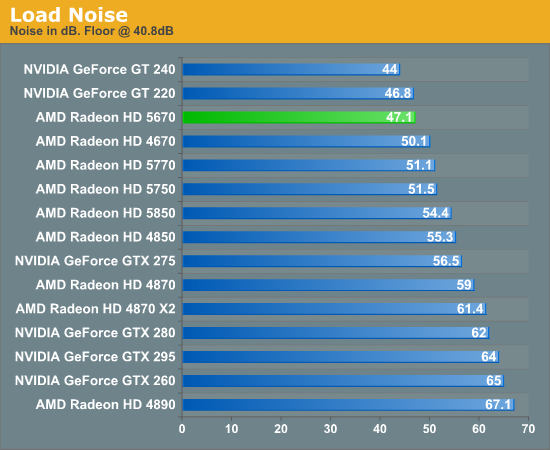
Finally there’s noise. As is the case with all of our other cards, the noise at idle is virtually indistinguishable from the noise generated by the rest of the computer.
At load the 5670 continues to be a quiet card, at only 3dB louder than idle. The only thing it falls behind here are the GT 220 and GT 240, both of which use dual-slot coolers and can afford the use of a larger, quieter fan. This is actually very impressive for a single-slot blower.
All of this data points to the 5670 making for a good HTPC card, certainly one as good if not better than the GT 200 series, and definitely better than the 4670. It’s cool and quiet, everything an HTPC card needs. However we’re more interested in where the 5500 series would place here – few HTPCs need this much rendering power, and with the 5500 series sub-50W power draw, it may be an even better choice.










73 Comments
View All Comments
Spoelie - Friday, January 15, 2010 - link
Because the GPU can never truly be isolated, the CPU/memory/buses need to perform some work too to keep the GPU fed with data and instructions to process.Slaimus - Thursday, January 14, 2010 - link
It is not too long ago that the Geforce 6200 debuted at $150. Low end gaming cards are slowly pickup up prices again.dagamer34 - Thursday, January 14, 2010 - link
When do the low profile 5650/5670 cards come out? I've been waiting one for my HTPC to bitstream Blu-ray HD codecs.SmCaudata - Thursday, January 14, 2010 - link
Unless you already have an HTPC why would anyone get this card. If building a new HTPC you could get a Clarkdale to bitstream the audio-codecs.Also...why do we care if it is bitstreamed? I have a reciever that can decode this but it doesn't matter if the digital information is converted to PCM before or after the HDMI cable. The only advantage is to see those lights on the front of my reciever...
papapapapapapapababy - Thursday, January 14, 2010 - link
future what? dx11 at 5fps? no thanks ati, remember the 4770? that was a good sub $100 card, (thanks) this crap is overpriced, $45 or bust.TheManY2K3 - Thursday, January 14, 2010 - link
Ryan,I don't see any of the applications at 12x10 include data for the 8800GT, however, you are comparing the 8800GT to the HD5670 in most applications.
Could you include the 8800GT in the 12x10 data, so that we can accurately gauge the performance of the HD5670?
Ryan Smith - Thursday, January 14, 2010 - link
The 8800 GT data was originally collected for past articles, where we started at 16x10. The 8800 GT isn't part of my collection (it's Anand's) so I wasn't able to get 12x10 data in time for this article.silverblue - Thursday, January 14, 2010 - link
It's probably fair to point out that, in most tests, the 5670 is very close to the 8800, and as such listing it may not mean anything. However, the 1280x1024 tests are also without AA - it might be nice to see the effect of turning AA on with this oldie but goodie as compared to the more modern competition, so including it may make sense. You may think that the higher core clock of the 5670 would give it an advantage without AA but if it goes anything like Batman, this would probably be an incorrect assumption as well.pjladyfox - Thursday, January 14, 2010 - link
Last I looked ANY Radeon card with the x5xx, x6xx, or x7xx model number was denoted as a mainstream card which is clearly noted here:http://en.wikipedia.org/wiki/Radeon#Product_naming...">http://en.wikipedia.org/wiki/Radeon#Product_naming...
By that definition that means that these cards were designed to run in systems that have power supplies from 350 to 400w, support HD quality video, and support games at a resolution of no higher than 1440x900 at medium quality settings with 2x AA and 8x anisotropic filtering. By putting them at settings that most will not run these cards at it makes these results for the most part worthless.
I mean who cares how these cards run at 1920x1200 at high detail settings since we already know they're going to fail anyway? I'm more interested in how these run with all the details on at say 1440x900 or possibly 1680x1050 which are the more common widescreen monitors most people have.
For that matter where are details about how these cards compare running HD quality video, if the fan speed can be controlled via speedfan, or even if they have fixed some of the video quality issues like black crush when outputting via HDMI?
Ryan Smith - Thursday, January 14, 2010 - link
We traditionally run every game at 3 resolutions, particularly since some games are more GPU-intensive than others. Based on the 12x10 performance, I decided that 10x7 would be silly and instead went up a level to 19x12 - a few games were actually playable even at those high resolutions.16x10 is accounted for, and 12x10 is close enough to 14x9 that the results are practically the same.
HD Video: All the 5000 series cards, except perhaps the Cedar are going to be exactly the same.
Fan speed: Can be modified (I use it to cool down the cards before extraction after running FurMark)
Black Crush: I honestly have no idea